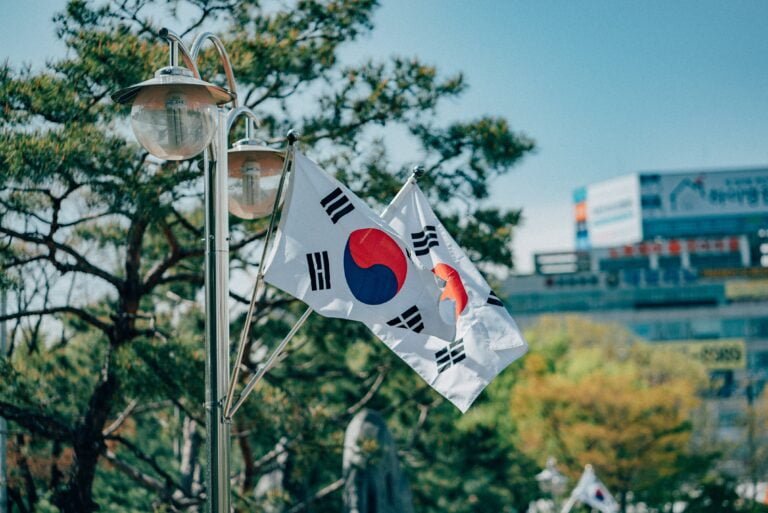South Korea Business Etiquette: How To Avoid Career-Ending Faux Pas
The distinctive South Korean business etiquette, an integral part of doing business in the nation, might easily overwhelm foreign companies and individuals. However, it’s essential to understand it when entering the South Korean market. In this article, we discuss the intricate South Korean business etiquette, the significance of understanding business hierarchy in the country, and essential practices like business card etiquette.
To embark on a business journey in a foreign land, especially a culturally rich country like South Korea, takes more than just business acumen; it demands an understanding of local customs, traditions, and etiquette. Navigating business interactions with grace and confidence and being completely aware of subtle gestures and practices can make or break a deal.
Individuals and tech startups eager to make their mark in the South Korean market can consult William B. Choi for expert guidance and mentoring. To ensure your venture is built on a solid foundation of cultural understanding, reach out to us soon.
Importance of Understanding Business Etiquette in South Korea
Anyone seeking to establish successful professional relationships in this East Asian economic powerhouse must understand its business etiquette. With its rich history and rapid modernization, it integrates traditional values into contemporary business practices.
Deeply rooted in trust, respect, and hierarchy, these local customs can help with:
- Building Trust: South Korean business dynamics thrive on mutual trust. Understanding local etiquette makes it easier to foster trust with partners and colleagues.
- Navigating Relationships: Respect is the foundation of South Korean business interactions. Proper etiquette will help establish and maintain strong business relationships.
- Facilitating Communication: Understanding the nuances of communication, such as indirect refusals, greeting with a bow and handshake, and honorifics, can help prevent misunderstandings.
- Showcasing Professionalism: Demonstrating knowledge of local business etiquette showcases a professional image, which is vital for successful market entry.
- Cultural Integration: Adapting to business etiquette aids in smoother cultural integration and offers an enriching experience beyond just business interactions.
- Ensuring Success: Adhering to local customs can make all the difference between securing a deal and unintentionally offending a potential partner.
Recognizing and respecting South Korean business etiquette is pivotal for successfully navigating the business landscape, bridging cultural gaps, and forging meaningful business relationships.
Image by katemangostar on Freepik
Key Aspects of South Korean Business Hierarchy
Strongly influenced by Confucian principles, South Korea’s business hierarchy is deeply embedded in its socio-cultural fabric.
The primary emphasis is on respect for elders and superiors for shaping interactions and decision-making. This hierarchical structure dictates the top-down approach to decision-making, with higher-ups making critical decisions and subordinates usually respecting and following them without much dissent.
Employees seldom contradict or challenge their superiors openly within business settings, valuing harmony and respectfulness.
In meetings, it’s customary to greet the most senior person first. This respect for seniority also extends to seating arrangements and dining etiquette.
Understanding one’s position within this hierarchy is essential, as interactions, including discussions and greetings, hinge on these established protocols. With considerable importance given to titles, it’s customary to address colleagues and partners by their official titles or surnames unless specified otherwise.
“Injeong,” or building and maintaining harmonious relationships within the hierarchy, is essential. Personal relationships often influence business decisions and partnerships.
Business Card Etiquette in South Korea
South Korean business etiquette also extends the exchange of business cards. Here are some key points that can help display professionalism in this regard:
- Presenting Business Cards: A business card must be presented with both hands, ensuring the text faces the recipient. This gesture demonstrates respect and attentiveness.
- Receiving Business Cards: When receiving a business card, always take a few moments to study the card before placing it on the table or a cardholder. Reading the card in front of the giver shows respect for their position and company.
- Handling with Respect: Business cards shouldn’t be tucked away hastily, written on, or stored in pockets. Instead, they should be placed in a designated place or a cardholder. Careless treatment of a business card might be perceived as disrespectful.
- Bilingual Cards: Foreigners doing business in South Korea must consider having one side of the business card in English and the other in Korean; it’s a thoughtful gesture.
- Position and Title: Ensure your business card clearly states your title. In South Korean business culture, status and hierarchy are significant; the card clearly explains one’s professional standing.
Meeting and Greeting: Setting the Tone Right
First impressions are crucial in South Korea, and the initial meeting and greeting set the foundation for future business relations. Here are the essentials to keep in mind:
- Bow: A bow is the traditional form of greeting, signifying respect. The more the seniority of the person you’re greeting, the deeper the bow.
- Handshakes: Following a bow, handshakes can often be gentle and prolonged. Supporting the right forearm with the left hand is customary to show additional respect, especially when greeting someone senior. A slight bow can accompany the handshake.
- Proper Address: Always use surnames or formal titles until invited to do otherwise. Generally, “Mr.” or “Ms.” followed by the person’s surname is appropriate if the person’s title is not known.
- Eye Contact: While maintaining eye contact is considered a sign of confidence in many Western cultures, it’s respectful to avoid prolonged eye contact, especially with those senior in age or rank, in South Korea.
- Wait to be Introduced: In group settings, waiting for a formal introduction rather than introducing yourself is polite. This ensures hierarchical respect is maintained.
Foreigners must attempt to understand and embrace these etiquettes to navigate their initial interactions seamlessly, fostering mutual respect and trust.
Business Attire: Dressing for Success
In the realm of South Korean business, attire isn’t just about personal style but a reflection of professionalism and respect for counterparts and customs. To follow the appropriate business attire, ensure:
Image by Freepik
- Conservatism: Both men and women are expected to dress conservatively. The typical dress code for men is business suits in neutral colors like black, navy, or grey, white shirts, and dark ties.
- Women’s Attire: Conservative dressing for women comprises knee-length skirts or dresses. Pantsuits are also acceptable, but the attire should be modest, avoiding flashy or overly revealing clothing.
- Seasonal Adjustments: Although suits are standard, the fabric may vary with seasons. Lighter materials for humid summers and heavier ones for the winters are preferred.
- Attention to Detail: Polished shoes, well-ironed clothes, and attention to accessories showcase respect for the business setting.
- Avoid Over-Accessorizing: Overly bright accessories or flashy jewelry may be considered distracting and are best avoided.
Gift Giving: A Vital Business Practice
In South Korea, gift-giving is more than just a polite gesture; it symbolizes respect, goodwill, and the intent to foster a harmonious relationship.
Unlike some Western cultures where gifts may be considered improper or raise concerns about influence, it’s an expected and appreciated gesture in South Korea, especially during the initial meetings. It’s the act that counts rather than the value of the gift.
- First Meeting Gesture: It’s a custom to offer a gift, especially during an initial meeting, to set a positive tone. The act signifies appreciation and a genuine interest in forging a relationship.
- Wrapping Matters: Ensure aesthetically pleasing wrapping. Immaculate presentation, often in bright colors like red or yellow, helps enhance the gift’s perceived value.
- Both Hands: Use both hands when presenting or receiving a gift. This displays respect and consideration for the gift.
- Reciprocity: Upon receiving a gift, it’s polite to reciprocate with one of similar value at a subsequent meeting. It helps maintain a balance in the relationship.
- Avoiding Misunderstandings: Certain items, like scissors or knives, can symbolize the severing of a relationship and are best avoided.
Certain gifts are considered traditional and well-received in South Korea, even for first meetings. Some common gift items include high-quality alcohol, flower and fruit baskets, artisanal goods, perfumes, and cosmetics.
If you’re from a foreign country, gifts representing your region or culture are particularly appreciated. As relationships deepen, the nature of gifts might evolve, reflecting mutual understanding and growing ties.
Dining Etiquette: Building Bonds Over Meals
Dining in South Korea isn’t merely about sharing a meal; it’s a vital platform for building and strengthening business relationships.
After-work dining or drink get-togethers, commonly known as “hoesik,” play a significant role in office culture and are seen as an opportunity for coworkers to bond, discuss work in a less formal environment, and build team rapport. While participation in hoesik isn’t mandatory, it’s often considered an unwritten duty, reflecting commitment to the team and the organization.
The dining table rituals and etiquette reflect the nation’s deep-rooted values of respect, hierarchy, and communal bond.
- Punctuality: Arriving on time is essential; it shows respect for the host and the occasion.
- Wait to Begin: Always wait for the most senior person to start eating; their lead sets the pace for the meal.
- Using Utensils: South Koreans typically use metal chopsticks and a spoon. Ensure you place them back on the chopstick rest after use, and never stick chopsticks upright into a bowl of rice, as this resembles a funeral right.
- Pouring Drinks: Use both hands to hold the bottle when pouring a drink, especially alcohol. If someone else is pouring, hold the glass with both hands as a sign of respect.
- Paying the Bill: Traditionally, the eldest or the highest-ranking person pays. However, offering to contribute is a good gesture, which the host might mostly decline.
Dining is seen as a time for conversation and relationship-building. While business may be discussed, it’s an opportunity to connect on personal levels, fostering trust and camaraderie for effective professional interactions.
Navigating Communication Challenges
Effective communication is critical in any business setting, but in South Korea, it requires understanding both spoken and unspoken rules.
Image by tirachardz on Freepik
- Hierarchical Respect: The language used often changes depending on the listener’s rank or age. The appropriate level of politeness and use of honorifics is essential to show respect.
- Indirectness: South Koreans often value indirect communication to maintain harmony. Since being too blunt may be perceived as rude, reading between the lines and understanding non-verbal cues is crucial.
- Avoiding Refusal: Saying ‘no’ directly can be seen as confrontational. South Koreans tend to employ subtler means to express disagreement or refusal, such as uncertainty or hesitancy in their responses.
- Feedback Nuances: Positive feedback is often given openly, while constructive criticism is usually delivered in private to save face and maintain a person’s honor.
- Understanding ‘Yes’: A nod or an affirmative needn’t always signify agreement. Sometimes, it means one has heard or understood, not necessarily consented.
- Situational Awareness: The concept of “nunchi,” a kind of situational awareness, is pivotal in South Korean interactions. It involves reading a room, understanding social dynamics, and reacting accordingly.
Understanding these communication subtleties can help foster genuine understanding and respect in South Korean business interactions.
Final Thoughts on South Korea Business Etiquette
Facilitating smooth business operations for a successful venture in the dynamic South Korean market involves multiple factors, including business etiquette. It’s wise to be well-equipped with the etiquette to foster genuine relationships built on mutual respect and understanding.
Ensure every bow, every handshake, and every meeting is a step towards lasting success.
Featured Image Credit: Image by Freepik







